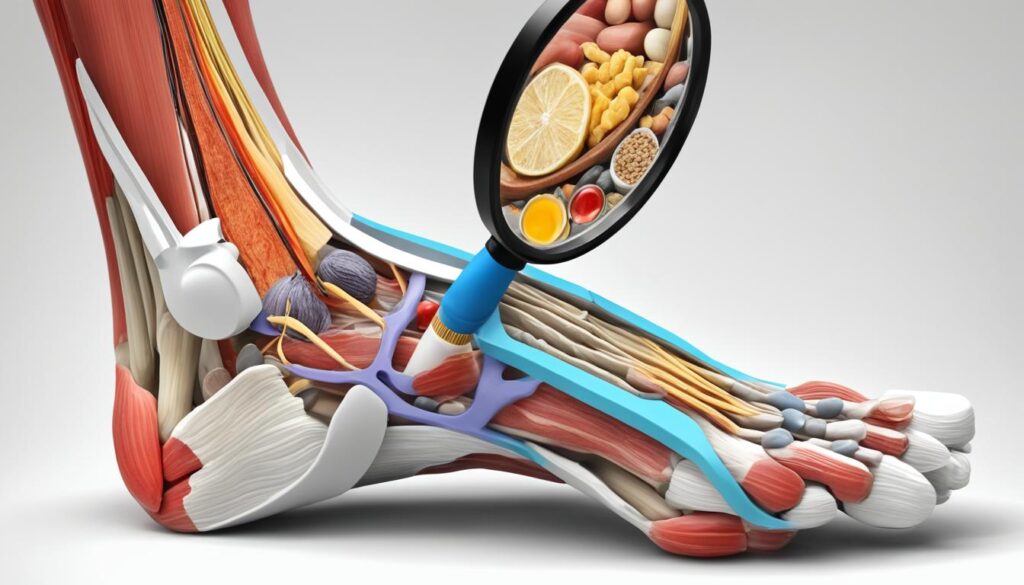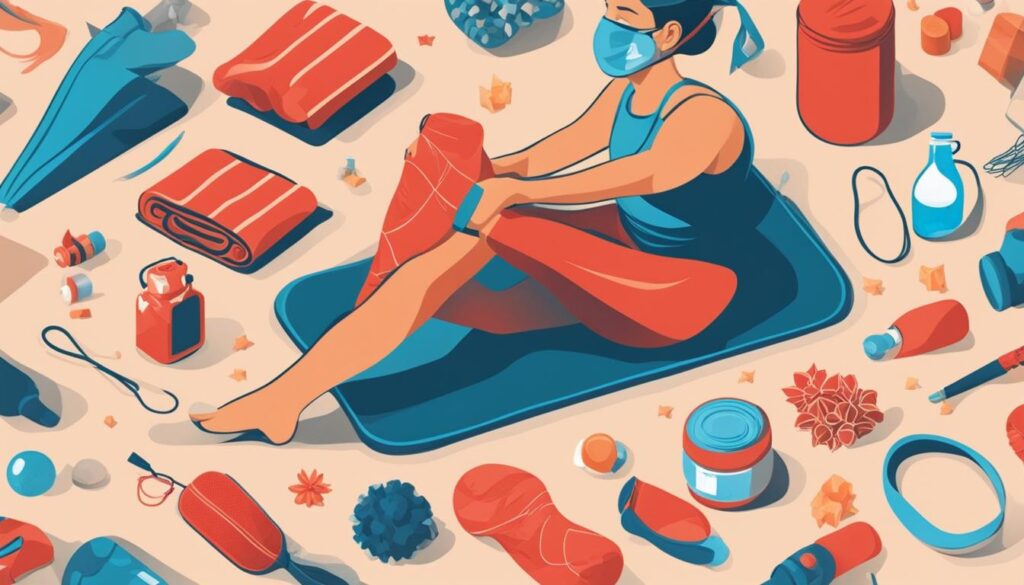Coping with foot cramps can be incredibly disrupting. Characterized by sudden, involuntary muscle contractions, foot cramps often occur during physical activity or even during sleep, interrupting your daily routine or peaceful rest. While usually harmless, these cramps can vary in intensity and sometimes, might even be extremely debilitating. If you’ve ever wondered about how to relieve foot cramps or are looking to find some practical foot cramp solutions, we’ve got you covered.
This section delves into the triggers of foot cramps, from improper footwear to dehydration, muscle exhaustion, certain medications, and electrolyte imbalances. We’ll also explore some easy remedies you can use to provide immediate relief for your cramps, like stretching, walking, or massaging the affected area and the application of heat or cold compresses. And if your cramps persist, causing significant discomfort or potential circulation issues, we’ll discuss when to seek help from a podiatrist.
Key Takeaways:
- Foot cramps are characterized by sudden, involuntary muscle contractions that can disrupt normal activities and sleep.
- Cramps can be triggered by various factors, from dehydration and muscle fatigue to improper footwear and certain medications.
- Practical foot cramp solutions include stretching, massage, heat or cold therapies, and ensuring adequate hydration and electrolyte levels.
- Seeking professional help is advisable if cramps persist, become extremely painful, or affect circulation.
- Maintaining foot health through preventive measures can significantly help in managing and relieving foot cramps.
Understanding the Agony of Foot Cramps and Their Triggers
When it comes to the common occurrence of foot cramps, understanding its causes can lead to a more effective management and prevention strategy. As a result of involuntary muscle contractions, foot cramps can sneakily arise at rest, during the middle of a task or even disrupt a peaceful night’s sleep.
Several factors, often interrelated, are identified as foot cramp triggers. A poor choice of footwear, for instance, can provoke unnecessary strain on foot muscles, leading to these spasms. Dehydration and overworked muscles constitute another well-known duet influencing the occurrence of foot cramps. In addition, inadequate balances of essential electrolytes, such as potassium, calcium, and magnesium, often caught off-guard by certain medications, leave muscles vulnerable to involuntary contractions. Meanwhile, underlying health conditions such as diabetes and hypothyroidism can also contribute an extra layer to the complexity of cramp triggers.
| Foot Cramp Triggers | Preventing Foot Cramps |
|---|---|
| Poor choice of footwear | Choose shoes that provide appropriate support |
| Dehydration | Ensure adequate hydration especially during exercise |
| Overworked muscles | Incorporate rest and avoid overexertion |
| Electrolyte imbalance | Maintain a diet rich in calcium, potassium, and magnesium |
| Certain medications | Consult with a healthcare provider to address possible side effects |
| Underlying health conditions | Seek regular medical check-ups especially for conditions like diabetes and hypothyroidism |
Alarmingly, foot cramps not only cause significant discomfort but they can also unexpectedly disrupt daily activities. Fortunately, these cramps, despite their inconvenient intrusions, can typically be resolved with thoughtful lifestyle modifications and regular stretching routines. This guide aims to provide a comprehensive understanding of foot cramps and their triggers to assist readers in navigating and managing the potential agony they can cause.
Foot Cramp Solutions: Stretching, Massage, and Heat Therapy
Managing foot cramps can be a daunting task, especially when they occur unexpectedly. Luckily, natural foot cramp remedies such as stretching, massage, and heat therapy have shown promising results in alleviating pain and discomfort.
Stretching Techniques for Immediate Relief
Stretching is one of the most effective immediate remedies for foot cramps. Sudden cramp onset can be tackled by gently stretching the muscle, standing up, or walking around to relieve tension. Engaging in specific stretches, such as calf stretches, can help when a foot cramp strikes. They can also be practiced as a proactive measure to reduce the likelihood of suffering from cramps, especially before bedtime.
The Role of Deep Tissue Massage
Deep tissue massage is another effective method for managing foot cramps. It improves blood circulation and eases muscle tension, providing immediate relief. A regular deep tissue massage can significantly lower the frequency of foot cramps, making it a vital part of your foot care routine.
When to Apply Heat or Cold to Alleviate Cramps
The choice between applying heat or a cold compress depends on the cramp’s nature and timing. Warmth can be ideal for relaxing tense muscles, often providing relief from chronic cramps. On the other hand, cold compresses can effectively numb and reduce pain during acute cramps.
While these are excellent remedies for foot cramps, it’s crucial to remember that every individual is unique when it comes to managing foot cramps. Therefore, it is beneficial to understand what works best for you and incorporate it into your foot care routine.
“
The Importance of Hydration and Balanced Electrolytes in Managing Foot Cramps
When it comes to foot cramp prevention, two critical factors often take center stage: hydration and electrolyte balance. Both of these elements directly interact with our muscles and substantial deficits can make muscles more prone to dehydration and cramps.

Proper hydration is not about merely drinking large volumes of water. It requires a delicate balancing act to satisfy your body’s needs, particularly during periods of physical activity or in warmer climates. Neglecting hydration could leave your muscles susceptible to cramps. Therefore, staying well-hydrated is a crucial preventive measure against foot spasms.
Just as integral to this process are electrolytes – essential minerals that carry an electric charge. They play vital roles in a host of bodily functions, including maintaining proper fluid balance and facilitating nerve and muscle functions. When an electrolyte imbalance occurs, often due to excessive sweating, diarrhea, or insufficient diet, your muscles might respond with cramps.
| Electrolyte | Role | Sources |
|---|---|---|
| Potassium | Helps nerves and muscles communicate | Bananas, Broccoli |
| Magnesium | Necessary for muscle contractions | Almonds, Spinach |
| Calcium | Involved in muscle contraction | Milk, Leafy Greens |
In addition to drinking enough water, it is essential to ensure your diet includes electrolyte-rich foods. Incorporating sources of potassium, magnesium, and calcium such as bananas, almonds, and leafy greens can help restore electrolyte balance and reduce the frequency of cramps. Staying on top of these levels is crucial not only to alleviate current cramps but also as an ongoing preventative strategy.
Preventing Nocturnal Foot Cramps: Tips for a Restful Night
When nighttime pulls the world into a state of calm, a sudden foot cramp can stir up a whirlwind of distress. These unwanted guests often infiltrate our peaceful slumbers, causing unrest and discomfort. Thankfully, we can adopt certain practices and adjustments to minimize the occurrence of these nocturnal foot cramps so we can ensure a peaceful night.
Adjusting Sleep Posture and Bedding Arrangements
Our sleeping positions can greatly influence blood circulation, which is a crucial factor in preventing foot cramps. Optimizing one’s sleep posture, such as sleeping on the back or side with a pillow beneath the knees, can be a significant game-changer. This position helps in enhancing blood flow, thus reducing the likelihood of muscle spasms. Likewise, bedding arrangements can also either alleviate or exacerbate the situation. Untucking bed covers and leaving enough space for the feet to move freely can substantially alleviate the onset of foot cramps, enabling us to rest more comfortably.
Lifestyle Changes for Minimizing Nighttime Cramps
Aside from adjusting sleep environment, certain lifestyle habits can also contribute to reducing the likelihood of foot cramps at night. Incorporating regular stretching exercises in our daily routine can aid in easing muscle tension and promote foot cramp relief. Moreover, maintaining a level of physical activity that neither overexerts nor underutilizes the feet can strike a beneficial balance, reducing the chance of preventing foot cramps. With these techniques harnessing how to relieve foot cramps at night, the risk of unwanted nocturnal interruptions can be substantially minimized, blessing us with uninterrupted and restful nights!
Natural Foot Cramp Remedies: Nutrition and Home Care Strategies
Foot cramps can be a bothersome affliction. Luckily, nature has provided us with various remedies that can alleviate the discomfort caused by these unwelcome muscle spasms. A crucial means to combat foot cramps comes from ensuring a nutrient-rich, balanced diet. Many don’t realize that certain nutrient deficiencies can lead to foot cramps. Equally as important, adopting a regimen of essential dietary and home care strategies can aid in mitigating these painful episodes.

The Power of a Well-Balanced Diet
Consuming a well-balanced diet rich in key nutrients can help address potential nutrient deficiencies, which commonly trigger foot cramps. Certain nutrient deficiencies such as vitamins B complex, magnesium, and potassium can lead to muscle spasms. These deficiencies can be placated through a diet inclusive of whole grains, beans, nuts, seeds, and unsweetened dried fruit. Emphasizing these foods within your diet can serve as one of the most potent dietary remedies for foot cramps.
Supplementation: When to Consider It
Despite our best efforts, sometimes a balanced diet may not provide the necessary nutrients to fend off foot cramps. In such cases, supplementing might be a beneficial addition to your dietary routine. Magnesium, for example, is often recommended by healthcare professionals to augment the body’s natural cramp defenses. Research has supported the use of magnesium for cramp relief due to its muscle-relaxing properties.
However, it’s important to engage in a consultation with a healthcare provider before starting any supplementation. This ensures that the supplements are safe for your individual health needs and that they address the root cause of the cramps effectively.
Avoidable Factors: Understanding the Impact of Footwear and Activity Level
Foot cramps can often be exacerbated or even caused by wearing improperly fitting shoes or engaging in strenuous physical activities without sufficient preparation. Shoes that lack appropriate support put additional strain on foot muscles, potentially leading to cramping. Hard surface exposure can also elevate the risk of muscle spasms.
Selecting the right footwear is a cornerstone in preventing foot cramps. It is crucial that shoes offer adequate support, cushioning, and a comfortable fit. Investing time and thought into choosing footwear can significantly reduce the strain and subsequent risk of cramping in your feet.
- Ensure shoes are neither too tight nor too loose
- Opt for shoes with proper arch support
- Choose footwear with sufficient cushioning to absorb shock when walking or running
- Try to reduce time spent on hard surfaces to lessen severity and frequency of foot cramps
“Your feet carry you through life, it’s important to take care of them with good footwear and rest”
Besides footwear, preparation before engaging in physical activities and proper management of activity levels can minimize the occurrence of foot cramps. Giving your muscles ample time to adapt to different levels of exertion can prevent overstraining and resultant cramping.
Table: Guidelines to Manage Activity Levels
| Activity | Guidelines |
|---|---|
| Walking or Running | Start with shorter distances, and gradually increase as your muscles adapt. Make sure to wear supportive shoes and on softer surfaces where possible. |
| High-intensity workouts | Ensure adequate warm-ups and cool-downs are in place. Progressively increase the intensity of your workouts. |
| Standing for Extended Periods | Take regular breaks to rest your feet and stretch your muscles. Opt for comfortable, well-cushioned footwear. |
When to Seek Professional Help: Signs You Should Visit a Specialist
When foot cramps become a frequent disturbance and disrupt routine activities, it may be time to consider professional foot cramp treatment options. It is pivotal to acknowledge that sometimes, home remedies may not alleviate persistent discomfort and in such instances, visiting a specialist is advisable.
Recognizing Persistent Foot Cramp Issues
Foot cramps can range in severity, but when they begin to appear more frequently, causing intense pain and accompanied by symptoms such as swelling, redness, or changes in the structure of the foot are noticed, it may be a sign of a more severe issue. Undertaking a professional examination is imperative in these cases. A healthcare provider or foot cramp specialist can conduct a thorough assessment, potentially identifying if the cramps are indicative of circulation problems or nerve compression concerns.
The Role of a Podiatrist in Foot Health
A podiatrist is a foot health professional who specializes in diagnosing and treating conditions affecting the foot, ankle, and related structures of the leg. They can provide a personalized regime to enhance foot health, motivating patients to step towards a pain-free life.
A podiatrist may provide strategies such as personalized exercises, recommend footwear designed to foster foot health, or even support the use of orthotics as part of a comprehensive treatment plan. These interventions aim to directly target the root cause of foot cramps, thereby significantly improving the quality of life for people struggling with persistent foot cramps. Therefore, if home remedies have not proven successful in managing foot cramps, visiting a podiatrist for cramps should be considered as the next step.
Conclusion
As we draw our exploration of foot cramps to a close, it becomes clear that these nagging spasms are more common than many might assume. Thankfully, there are myriad foot cramp solutions at our disposal. Integral to tackling these frustrating intrusions into daily living and nighttime rest are practical home remedies, maintaining hydration, ensuring a nutrient-rich diet, and opting for properly fitting footwear.
Comprehending the triggers of foot cramps leads us to effective measures for managing foot cramps. Adopting preventive strategies is instrumental in lessening the discomfort associated with these muscle spasms. Making lifestyle choices like prioritizing hydration, favoring balanced meals, choosing the right shoes, and respecting your body’s limits when embarking on physical activity can all perhaps save you from sudden onslaughts of painful cramping.
While most instances of foot cramps can be adequately treated at home, it’s crucial not to negate the potential importance of professional consultation. If the cramps persist or grow more severe, or if they are accompanied by worrying signs like changes in foot structure, this warrants a visit to a healthcare professional. Remember that foot health plays a significant role in our overall well-being — foot cramp relief is not just about dispensing temporary discomfort, but ensuring a consistent high quality of life.





